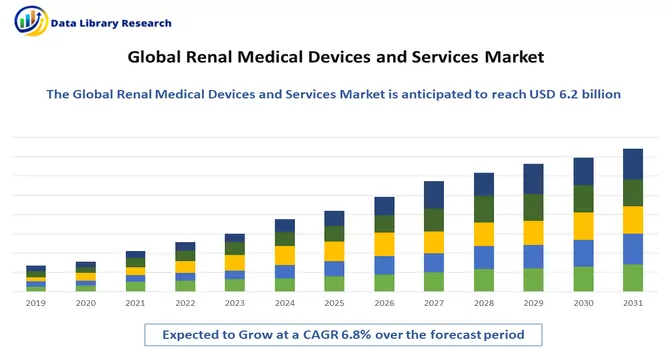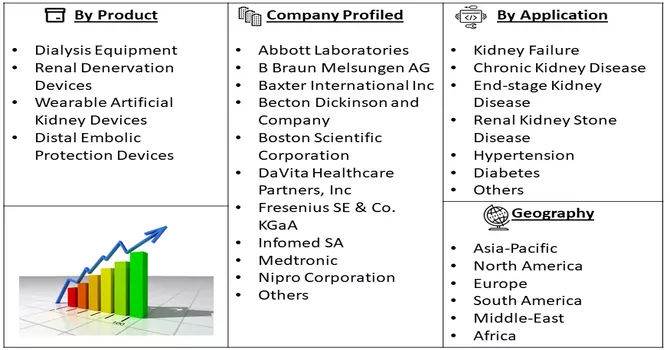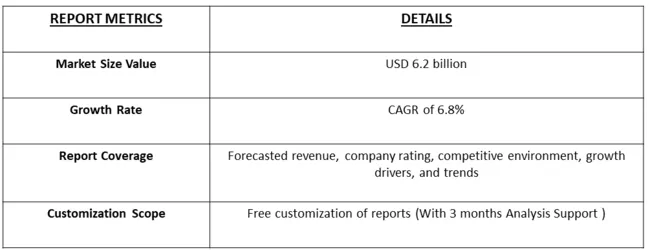The Renal Medical Devices Services Market is currently valued at USD 6.2 billion in 2023 and is likely to register a CAGR of 6.8% during 2024–2031.

Get Complete Analysis Of The Report - Download Free Sample PDF
The renal medical devices and services market, encompassing a wide array of products and solutions dedicated to renal care, demonstrates a vital and evolving sector within the healthcare industry. Renal medical devices cater to the diverse needs of individuals with kidney-related disorders, ranging from diagnostic tools to renal replacement therapies.
The market is characterized by continuous advancements in technology, offering innovative solutions for the diagnosis, monitoring, and treatment of renal conditions. Key components include dialysis machines, diagnostic imaging devices, and renal biopsy kits. Additionally, services such as renal care management and home-based dialysis solutions contribute to the comprehensive landscape of renal healthcare. The increasing prevalence of chronic kidney diseases, coupled with a growing aging population, propels the demand for these devices and services globally. As the industry advances, a focus on personalized and integrated care approaches, along with technological innovations, defines the market's trajectory, fostering improved patient outcomes and addressing the evolving challenges in renal healthcare. A fundamental growth-driving factor for the renal medical devices and services market is the escalating prevalence of chronic kidney diseases (CKD) worldwide. The rising incidence of CKD, often linked to factors such as aging populations, diabetes, and hypertension, necessitates advanced and diversified solutions for renal care. Renal medical devices and services play a crucial role in managing various stages of kidney diseases, from early diagnosis to renal replacement therapies like dialysis. Moreover, the growing awareness of preventive healthcare measures and the increasing adoption of home-based dialysis options contribute to the expanding market. The demand for innovative technologies, including wearable devices for continuous monitoring and personalized treatment approaches, further propels market growth. As healthcare systems globally prioritize renal health, the renal medical devices and services market is poised for sustained expansion, driven by a commitment to addressing the complexities of kidney-related disorders and enhancing the overall quality of patient care.
Market Segmentation: The Renal Medical Devices and Services Market is segmented by Product (Dialysis Equipment, Renal Denervation Devices, Wearable Artificial Kidney Devices, and Distal Embolic Protection Devices), Application (Kidney Failure, Chronic Kidney Disease, End-stage Kidney Disease, Renal Kidney Stone Disease, Hypertension, Diabetes, and Others), and Geography (North America, Europe, Asia-Pacific, Middle-East and Africa, and South America). The report offers the value (in USD million) for the above segments.

For Detailed Market Segmentation - Download Free Sample PDF
Market trends in the renal medical devices and services industry underscore a dynamic landscape driven by technological advancements, patient-centric care, and a growing emphasis on home-based solutions. There is a noticeable shift towards portable and wearable devices that enable continuous monitoring of renal parameters, enhancing the management of chronic kidney diseases (CKD) and improving patient outcomes. The rise of telehealth and remote patient monitoring is influencing the delivery of renal care, allowing for more personalized and accessible services. Home-based dialysis options, marked by innovations in peritoneal and hemodialysis technologies, are gaining prominence, offering patients greater flexibility and convenience. Additionally, the integration of artificial intelligence and data analytics is enhancing diagnostics and treatment planning in renal healthcare. As the industry embraces these trends, the renal medical devices and services market is evolving to meet the increasing demand for innovative, patient-friendly, and technologically advanced solutions in the dynamic landscape of renal care.
Market Drivers:
The rising incidence of CKD
The escalating incidence of chronic kidney disease (CKD) stands as a pivotal driver for the renal medical devices and services market. The global surge in CKD is primarily attributed to aging populations, increasing rates of diabetes, hypertension, and other lifestyle-related factors. This prevalent health challenge necessitates advanced medical devices and services for early detection, accurate diagnosis, and effective management of CKD. The growing recognition of CKD as a public health concern has intensified research and development efforts within the renal healthcare sector, leading to innovative solutions, including diagnostic tools, monitoring devices, and personalized treatment modalities. As the prevalence of CKD continues to rise, the renal medical devices and services market plays a crucial role in addressing the evolving needs of a large and growing patient population, emphasizing the industry's commitment to advancing renal care on a global scale.
The increasing preference for home-based renal care solutions
The increasing preference for home-based renal care solutions represents a transformative trend driving the evolution of the renal medical devices and services market. Fueled by a growing emphasis on patient-centric care and the desire to enhance the quality of life for individuals with kidney-related disorders, there is a notable shift towards home-based renal care solutions. This includes the adoption of portable dialysis devices, remote monitoring technologies, and wearable devices, allowing patients to manage their renal health from the comfort of their homes. The advantages of increased convenience, reduced healthcare facility visits, and greater autonomy in treatment decisions are propelling the demand for innovative home-based solutions. As technology continues to advance, this trend is reshaping the landscape of renal care, emphasizing the industry's commitment to providing accessible, patient-friendly, and effective solutions for individuals managing chronic kidney conditions.
Market Restraints:
Several market restraints pose challenges to the renal medical devices and services market, with one significant factor being the high cost associated with advanced renal care technologies. The expenses related to the development, manufacturing, and implementation of sophisticated medical devices can limit accessibility, particularly in resource-constrained healthcare systems. Additionally, reimbursement challenges and the complexity of insurance coverage for certain renal procedures and devices can hinder widespread adoption. The intricate nature of renal diseases, including diverse patient responses to treatment, poses challenges in standardizing care and achieving consistent outcomes. Regulatory hurdles and the need for rigorous compliance further contribute to delays in introducing new devices to the market. Moreover, the evolving healthcare policies and budget constraints in various regions may impact the overall growth and adoption of renal medical devices and services. These multifaceted restraints collectively shape the intricate landscape of the renal healthcare sector, emphasizing the need for comprehensive strategies to address these challenges and promote the advancement of renal care technologies.
The COVID-19 pandemic has introduced a complex set of challenges and impacts on the renal medical devices and services market. Disruptions in healthcare systems, resource reallocation, and prioritization of COVID-19-related care have led to delays in elective medical procedures, including those related to renal healthcare. The shift towards telehealth and remote patient monitoring during the pandemic has influenced the delivery of renal care, creating both opportunities and challenges. While there is an increased focus on home-based solutions, logistical challenges in the supply chain, manufacturing disruptions, and financial strains on healthcare budgets have affected the market dynamics. The pandemic has underscored the importance of resilient and adaptable healthcare systems, emphasizing the need for innovation, flexibility, and digital solutions in the renal medical devices and services market to address ongoing challenges and ensure the continuity of essential renal care services.
Segmental Analysis:
Wearable Artificial Kidney Device Segment is Expected to Witness Significant Growth Over the Forecast Period
Wearable artificial kidney devices represent a cutting-edge innovation in the field of medical technology, aiming to revolutionize renal replacement therapy. These compact and lightweight devices provide continuous dialysis, offering enhanced mobility and flexibility for individuals with kidney failure compared to traditional hemodialysis machines. Key features include miniaturized filtration units, advanced sensors for blood and fluid management, and biocompatible materials to ensure safety. With wireless connectivity for remote monitoring, these devices are designed for energy efficiency and improved patient outcomes. Concurrently, other kidney-related technologies, such as implantable artificial kidneys and bioartificial kidneys, are advancing, providing a spectrum of solutions to address the complexities of kidney diseases. The dynamic landscape of kidney devices underscores a commitment to improving patient care and quality of life through technological innovation.
Kidney Failure Segment is Expected to Witness Significant Growth Over the Forecast Period
Kidney failure, a critical health condition, has spurred innovation in renal medical devices to enhance patient care. Wearable artificial kidney devices, compact and portable, stand out for providing continuous dialysis, granting patients newfound mobility. These devices feature miniaturized filtration units, advanced sensors for precise blood and fluid management, and biocompatible materials to ensure safety. Additionally, implantable artificial kidneys and bioartificial kidneys are emerging as potential long-term solutions. The evolving landscape of renal medical devices, driven by advancements in technology, aims to alleviate the challenges associated with kidney failure, marking a significant stride toward improved treatment modalities and enhanced patient outcomes.
North America Segment is Expected to Witness Significant Growth Over the Forecast Period
The North American region is anticipated to play a substantial role in driving market growth throughout the study period. This can be attributed to the well-established and organized healthcare system in the region, fostering a conducive environment for research and development initiatives. These policies not only encourage domestic but also attract global players to enter the United States and Canada. The presence of numerous global market players in these countries, coupled with a robust healthcare infrastructure, contributes to meeting the high and increasing demand, thereby fueling market expansion. Notably, the United States emerges as a key contributor to regional growth, driven by factors such as the growing prevalence of kidney diseases and a rising geriatric population. A study published in the Journal of Urology in April 2022 revealed that the 12-month incidence of kidney stones in the United States population was 2.1%, or 2,054 stones per 100,000 adults. This high prevalence of kidney stone disease is expected to be a driving force behind the growth of the renal medical devices and services market in North America over the forecast period. Furthermore, the United States is witnessing an upswing in research and development efforts aimed at innovative treatments for renal disorders. A notable example is the successful testing of the Kidney Project's implantable bioartificial kidney by researchers from the University of California San Francisco in September 2021. These advancements in renal medical devices are poised to significantly enhance the market landscape in North America in the coming years.

Get Complete Analysis Of The Report - Download Free Sample PDF
The analyzed market exhibits a high degree of fragmentation, primarily attributable to the presence of numerous players operating on both a global and regional scale. The competitive landscape is characterized by a diverse array of companies, each contributing to the overall market dynamics. This fragmentation arises from the existence of specialized solution providers, established industry players, and emerging entrants, all vying for market share. The diversity in market participants is underscored by the adoption of various strategies aimed at expanding the company presence. On a global scale, companies within the studied market are strategically positioning themselves through aggressive expansion initiatives. This often involves entering new geographical regions, targeting untapped markets, and establishing a robust global footprint. The pursuit of global expansion is driven by the recognition of diverse market opportunities and the desire to capitalize on emerging trends and demands across different regions. Simultaneously, at the regional level, companies are tailoring their approaches to align with local market dynamics. Regional players are leveraging their understanding of specific market nuances, regulatory environments, and consumer preferences to gain a competitive edge. This regional focus allows companies to cater to the unique needs of local clientele, fostering stronger market penetration. To navigate the complexities of the fragmented market, companies are implementing a range of strategies. These strategies include investments in research and development to stay at the forefront of technological advancements, mergers and acquisitions to consolidate market share, strategic partnerships for synergies, and innovation to differentiate products and services. The adoption of such multifaceted strategies reflects the competitive nature of the market, with participants continually seeking avenues for growth and sustainability. In essence, the high fragmentation in the studied market not only signifies the diversity of players but also underscores the dynamism and competitiveness that drive ongoing strategic manoeuvres. As companies explore various avenues for expansion, the market continues to evolve, presenting both challenges and opportunities for industry stakeholders.
Some of the key market players are:
Recent Development:
1) In May 2022, Medtronic and DaVita forged a collaborative partnership, marking the establishment of a novel kidney technology company. Leveraging DaVita's extensive experience as the foremost provider of dialysis services in the United States and drawing upon Medtronic's proficiency in developing medical technologies across various healthcare domains, the new venture aims to pioneer advancements in kidney care. This collaboration underscores a strategic synergy, combining DaVita's clinical insights with Medtronic's technological prowess to address evolving challenges and enhance patient outcomes in the field of renal health.
2) In January 2022, ReCor Medical, a subsidiary of Otsuka Medical Devices Co. Ltd., introduced the Paradise Ultrasound Renal Denervation System in Germany as a breakthrough for treating uncontrolled hypertension. This launch reflects ongoing efforts to introduce innovative solutions in the renal medical devices market, showcasing the global commitment to advancing therapeutic options and addressing unmet needs in the realm of renal healthcare.
Q1. What is the current Renal Medical Devices and Services Market size?
As per Data Library Research the Renal Medical Devices Services Market is currently valued at USD 6.2 billion in 2023.
Q2. At what CAGR is the Renal Medical Devices and Services market projected to grow within the forecast period?
Renal Medical Devices and Services market is likely to register a CAGR of 6.8% during the forecast period.
Q3. What are the Growth Drivers of the Renal Medical Devices and Services Market?
The rising incidence of CKD and The increasing preference for home-based renal care solutions are the Growth Drivers of the Renal Medical Devices and Services Market.
Q4. Who are the key players in Renal Medical Devices and Services Market?
Some key players operating in the market include
Data Library Research are conducted by industry experts who offer insight on industry structure, market segmentations technology assessment and competitive landscape (CL), and penetration, as well as on emerging trends. Their analysis is based on primary interviews (~ 80%) and secondary research (~ 20%) as well as years of professional expertise in their respective industries. Adding to this, by analysing historical trends and current market positions, our analysts predict where the market will be headed for the next five years. Furthermore, the varying trends of segment & categories geographically presented are also studied and the estimated based on the primary & secondary research.
In this particular report from the supply side Data Library Research has conducted primary surveys (interviews) with the key level executives (VP, CEO’s, Marketing Director, Business Development Manager and SOFT) of the companies that active & prominent as well as the midsized organization
FIGURE 1: DLR RESEARH PROCESS

Extensive primary research was conducted to gain a deeper insight of the market and industry performance. The analysis is based on both primary and secondary research as well as years of professional expertise in the respective industries.
In addition to analysing current and historical trends, our analysts predict where the market is headed over the next five years.
It varies by segment for these categories geographically presented in the list of market tables. Speaking about this particular report we have conducted primary surveys (interviews) with the key level executives (VP, CEO’s, Marketing Director, Business Development Manager and many more) of the major players active in the market.
Secondary ResearchSecondary research was mainly used to collect and identify information useful for the extensive, technical, market-oriented, and Friend’s study of the Global Extra Neutral Alcohol. It was also used to obtain key information about major players, market classification and segmentation according to the industry trends, geographical markets, and developments related to the market and technology perspectives. For this study, analysts have gathered information from various credible sources, such as annual reports, sec filings, journals, white papers, SOFT presentations, and company web sites.
Market Size EstimationBoth, top-down and bottom-up approaches were used to estimate and validate the size of the Global market and to estimate the size of various other dependent submarkets in the overall Extra Neutral Alcohol. The key players in the market were identified through secondary research and their market contributions in the respective geographies were determined through primary and secondary research.
Forecast Model
